As the world is hunkering down at home trying to figure out how to navigate through the coronavirus pandemic, I thought it might be of interest to research and share the recipe for a meal some Swiss resorted to during the Cholera pandemic almost 200 years ago.
Cholera Tart or Cholera Cake (a hearty, savory dish consisting of a pastry shell packed with a dense filling) was, supposedly, developed in the Valais region of Switzerland in 1832 when the Cholera pandemic that was sweeping the world began taking its toll in that region.
Seemingly healthy people were suddenly taken ill by this mysterious and terrifying disease, often dying a horrible death within hours or days. Too afraid to venture out for fresh meats, vegetables and fruits, people hunkered down in their homes and survived on whatever was in their larder. Not surprisingly, modern day recipes only bear some resemblance to the meal prepared from scraped-together ingredients. Said to include scraps of cured or dried meats, produce that could be stored for long periods such as potatoes, cabbage and onions, most likely dried rather than fresh apples and pears and a full-flavored cheese all encased in a pastry shell – Cholera Cake (or Tart) was an attempt to make a tasty dish from some rather bland ingredients. To learn more, here is the link to my radio program on this dish.
Despite the unappetizing name, I think the recipe I developed after researching the history is quite delicious. A printable recipe can be found at the bottom. Begin by gathering ingredients for the filling. Whatever is in the larder, although for this recipe, I used leeks (onions may be substituted), cabbage, apples, potatoes, lardon (a slab of bacon), thyme and a full-flavored Gruyère cheese.
 Place waxy, low starch potatoes in a pot of water with some salt. Bring to a boil and simmer until cooked through. If potatoes are large, cut them in half or quarters before boiling.
Place waxy, low starch potatoes in a pot of water with some salt. Bring to a boil and simmer until cooked through. If potatoes are large, cut them in half or quarters before boiling.
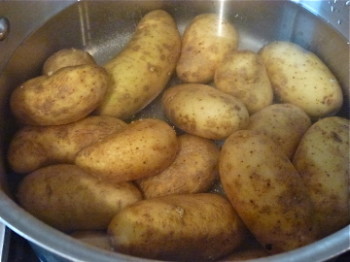 While potatoes are cooking, add bacon or finely cut pieces of lardon to a skillet and cook over medium heat.
While potatoes are cooking, add bacon or finely cut pieces of lardon to a skillet and cook over medium heat.
 When crispy, and all the fat has rendered out, remove the pieces with a slotted spoon and set aside in a large bowl.
When crispy, and all the fat has rendered out, remove the pieces with a slotted spoon and set aside in a large bowl.
Stem, clean and halve leeks. Slice lengthwise. Make thin, crosswise slices beginning at the base. Stop cutting when the tough tops are reached.
Add the cut leeks to the hot skillet. Add oil, if necessary. Cook until softened and lightly colored.
Remove from the skillet with a slotted spoon and add to the bowl with the bacon. Core and chop the cabbage.
Add the cabbage to the hot skillet. Add oil, if necessary. Cook until softened and lightly colored.
Add the cabbage to the cooked bacon and leeks. Salt and pepper, to taste, and stir to combine. If desired, add a pinch of dried sage, thyme or rosemary.
When the potatoes are cooked through, drain and peel (if have not peeled before cooking). Slice into discs or chunks.
Peel, core and slice apples. Cut slices from two of the apples into quarters. Cut remaining slices in half to use decoratively on top (as one does during a pandemic!).
Grate a very flavorful cheese. The other ingredients are somewhat bland-flavored so the more flavorful the cheese, the more flavorful the final dish.
To prepare the crust, line a deep cake pan (preferably with removable sides) with puff pastry dough. Purchased or homemade pâte brisée or, less desirable, pie crust can also be used. Crimp the top edges.
Having filling ingredients ready to assemble.
Place half of the potatoes at the bottom. Top with half the quartered apple slices, half the grated cheese then half of the cabbage/leek/bacon mixture.
Repeat.
Top with larger apple slices.
Bake until the apples are soft and the crust is golden brown. If the topping browns too quickly, lightly tent it with a piece of foil and continue baking until the crust has browned.
When the pan has cooled a bit, remove the spring locked sides. Do not attempt to un-mold if using a deep dish casserole or pan with non-removeable sides.
Dig in! Serve warm or at room temperature.
Store leftovers, covered, in the refrigerator. Reheat in the oven until just warmed through.
(Note: This horrible, preventable and treatable disease prevails in poorer countries. To learn more about Cholera and what can be done to help, please go to this link for the World Health Organization.)
- One package cold puff pastry (Blätterteig / pâte feuilletée / pasta sfoglia)
- ½ cup / 4 ounces / 115 grams lardon (or speck or bacon)
- oil, as needed
- 2 large leeks
- 1 small cabbage
- 1½ lbs / 750 grams potatoes (preferably a waxy, low starch variety)
- 2 cups / 1 lb / 500 grams grated Gruyere, Raclette or full flavor cheese
- 3 large apples (or pears or a mixture of both)
- 1 teaspoon dried or fresh thyme
- salt and pepper, to taste
- Wash potatoes. If large, cut into smaller pieces.
- Place the potatoes in a large pot. Add a teaspoon of salt.
- Bring to a boil. Reduce the heat. Simmer until just tender.
- Drain and set aside to cool.
- When cool enough to handle, scrape off the skin. (If using large potatoes, easier to peel before cooking.)
- Slice into flat discs or bite-size chunks.
- Cut lardon or bacon slab into small (1/4inch / ½ cm) cubes.
- Heat a skillet over medium heat and add the lardon.
- Sauté, stirring occasionally, until most of the fat renders out and pieces are nice browned.
- Remove with a slotted spoon and place in a large bowl.
- Thoroughly wash the leeks and cut off the root base.
- Make a shallow vertical slice and peel away the tough outer layer.
- Lay the leeks on a cutting board and slice in half lengthwise.
- Begin making half circle slices from the base up to where the tougher green leaves begin.
- If needed, add oil to the already hot skillet.
- Add sliced leeks and sauté until soft and lightly browned.
- Add to the lardon in the bowl.
- Halve the cabbage.
- Cut out the core and remove the tough outer layer.
- Cut each half into several pieces lengthwise then slice horizontally into bite-size pieces.
- If needed, add oil to the already hot skillet.
- Add the chopped cabbage and sauté until soft and lightly browned.
- Add to the lardon and leeks. Salt and pepper, to taste.
- Peel, core and thinly slice the apples.
- Keep slices long for one apple to decorate the top.
- Cut the other two apples into slightly smaller pieces.
- Have ready a 9 to 10 inch / 23 to 25 cm, deep-sided ( 3 inch / 7.5 cm) cake tin with removable sides or a deep casserole dish. If not using a non-stick pan, lightly butter or oil the sides and bottom.
- Lay the pastry into the pan.
- Press into the corners and up the sides.
- If higher than the pan, roll the top edges.
- If not using a round pastry, patch together so the dough covers the entire base and sides.
- Place half the potatoes in an even layer over the base of the pastry.
- Cover with half of the small apple slices.
- Sprinkle with half the cheese then spread half the leek, cabbage and lardon layer evenly over everything.
- Repeat.
- Decoratively top with the larger slices from the third apple.
- Bake in a pre-heated 350° F / 175° C oven until the filling is heated through and the pastry is crisp and golden brown, about 45 minutes to one hour.
- If the apple topping browns before the pastry is cooked through, lightly cover with foil.
- If using a pan with removable sides, allow to cool a bit before removing the cake from the pan.
- Serve warm or at room temperature.
- Leftovers should be stored in the refrigerator. Reheat in the oven.
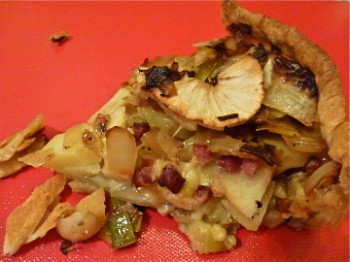
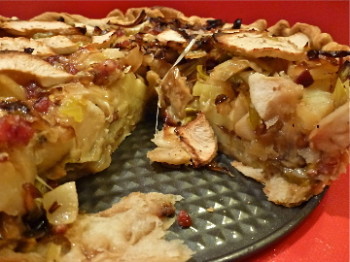



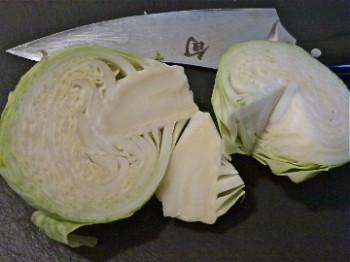
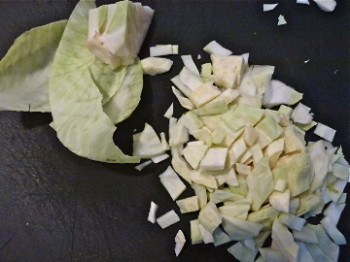
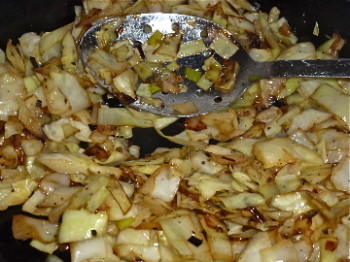
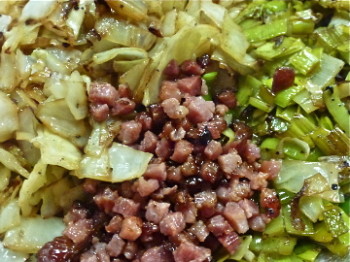
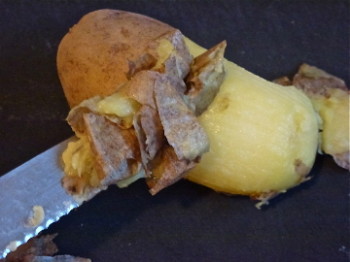

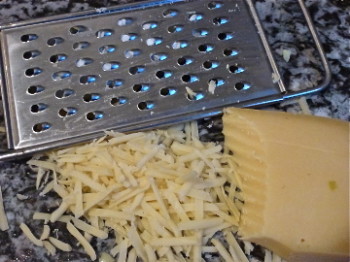
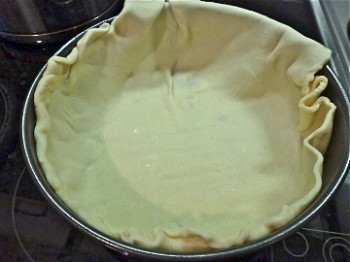
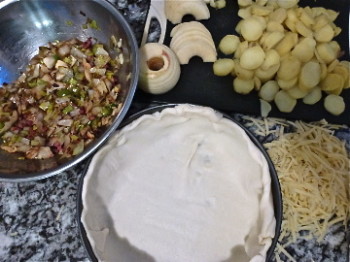
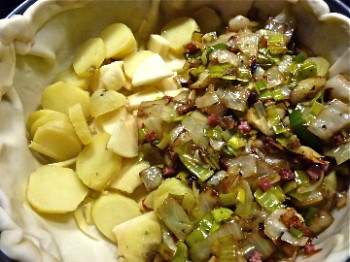

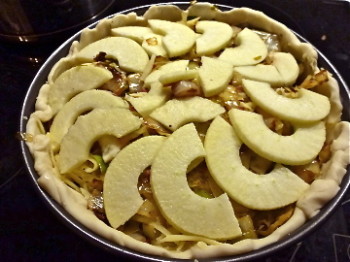
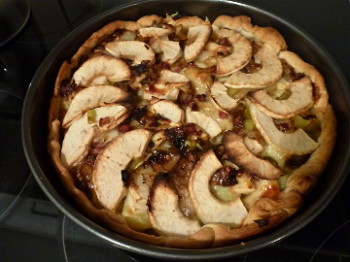
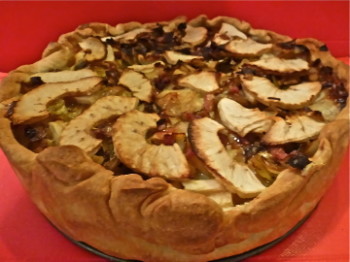
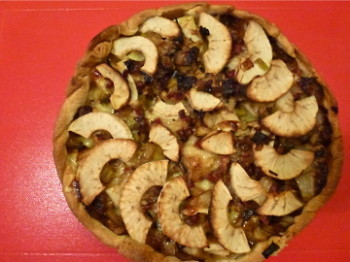





Thank you for the history of this dish! Tried it tonight in a valais village. Sounded weird but it was so tasty, in a puff pastry shell, with pine nuts and wonderful cheese.